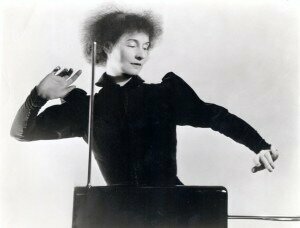
Lucie Rosen playing theremin
In 1919, the 23-year old scientist was conducting government research on a sensor that could detect the human aura. He was actually working on a gas meter to measure the density of various gases when he heard a high squeal as his hand approached the gas meter. “And when he brought his hand back to his body and away from the machine, it was a slower and lower squeal.” Theremin became intrigued and constructed a free standing musical instrument. He entertained his lab colleagues with little melodies, and by 1920 demonstrated his invention to sold-out venues across Europe. By 1928 he debut the instrument in the United States, appearing at Carnegie Hall and the Metropolitan Opera House. Once the Theremin was patented, commercial production rights were granted to RCA, one of the cutting-edge manufacturers of electronics. Of course, RCA did not realize that Dr. Theremin was also a KGB spy, charged with providing industrial espionage for the Soviet government.
Audiences throughout the world were fascinated, but because it turned out to be quite challenging to play, the instrument was not a commercial success. A number of accomplished performers, foremost among them Lucie Rosen, toured the United States. Rosen, who together with her husband founded the Caramoor Center for Music and the Arts in New York State, approached Bohuslav Martinů for a composition featuring the Theremin. Martinů, who had fled Europe in 1941 and was living in New York City, responded with his Fantasia for Theremin, Oboe, String Quartet and Piano, H.301, which premiered on 3 November 1945. The composition explores the outer edges of the Theremin’s dynamic and timbre range. Long-winding melodic lines blend and contrast with the harmonies offered by strings and oboe. Roughly 15 minutes in length, this work represents a serious technical challenge for the thereminist. A number of composers, including Edgard Varèse and Joseph Schillinger also explored the unique tonalities offered by the instrument.

Leon Theremin
Credit: http://www.thereminworld.com/
Bohuslav Martinů: Fantasia for Theremin, Oboe, String Quartet and Piano, H.301
Leon Theremin playing his own instrument




